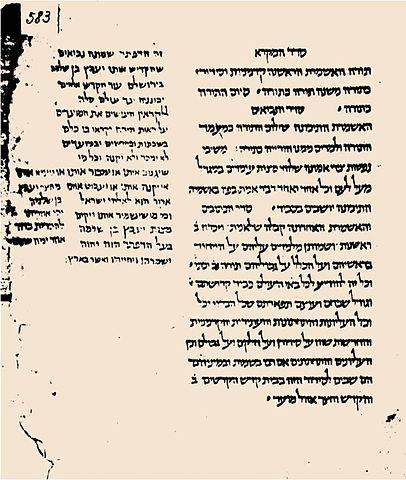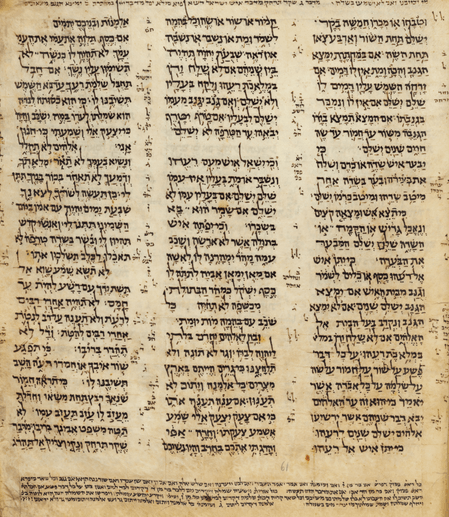We previously looked at the basic principles used in the discipline of Textual Criticism. We then applied these principles to the New Testament. By these measures the New Testament reliability exceeds that of any other ancient book.
But what about the books of the Old Testament? Are they as reliable and unchanged as the New Testament? What role do the Dead Sea Scrolls play in this?
The Old Testament: An Ancient Library
The Old Testament’s uniqueness comes in several ways. First it should be thought of more as a library since many authors wrote the various books of the Old Testament. Second, they wrote them a very long time ago. To appreciate the immense antiquity of the Old Testament writings, we compare them in a timeline with other ancient writings:
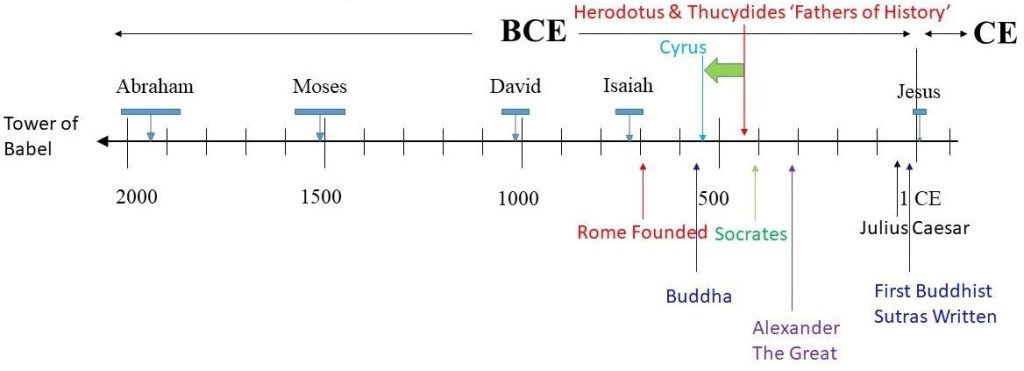
The timeline above places Abraham, Moses, David and Isaiah in history. They are the major characters of the Old Testament. Compare where they sit on the timeline with Thucydides and Herodotus, whom historians consider the earliest ‘Fathers of History’. Herodotus and Thucydides only lived when Malachi wrote the final Old Testament book. Their writings only looked back about 100 years before their time to conflicts between Greek city states, and between Greece and Persia. Other important historical persons and events like the founding of Rome, Alexander the Great, and the Buddha all come much later than the Old Testament characters. Essentially, the rest of the world only woke up to history when the Old Testament added its final books to its rather extensive collection.
Textual Criticism of the Old Testament Masoretic Text
The authors of the 39 Old Testament books wrote between 1500 BCE and 400 BCE. They wrote in Hebrew with small portions in the later books written in Aramaic. The blue band shows the 1100 year period when the various Old Testament books were written (1500 – 400 BCE):

These original writings are preserved today in Hebrew manuscript copies known as the Masoretic Text. Modern Bible translators use the Masoretic Text to translate the Hebrew Old Testament into today’s languages. So using the principles of Textual Criticism (see here for details), how reliable is the Masoretic Text?
The Earliest Existing Masoretic Copies
| Manuscript | Date of Composition |
| Codex Cairensis | 895 CE |
| Aleppo Codex | 950 CE |
| Codex Sassoon | 1000 CE |
| Codex Leningradensis | 1008 CE |
So you can see that the earliest existing Masoretic manuscripts date only starting from 895 CE. If we put these manuscripts in a timeline with the original writings of the Old Testament, we are given the following:

You can also see that the interval between the date of composition and the earliest existing copies (the primary principle in Textual Criticism) exceeds 1000 years.

Codex Cairensis
ישראל קרול, Public domain, via Wikimedia Commons
Codex Sassoon
Ardon Bar-Hama, Public domain, via Wikimedia Commons
The Dead Sea Scrolls

Effi Schweizer, Public domain, via Wikimedia Commons
In 1948, Palestinian shepherds discovered the Dead Sea Scrolls hidden in caves by the shores of the Dead Sea in Qumran. A shepherd boy had thrown some stones into the mouth of a cave higher up in the face of a cliff. He then heard the sound of clay jars breaking from the impact of the stones. Intrigued, he climbed up the cliffs and found the sealed clay jars with the Dead Sea Scrolls inside. The Dead Sea Scrolls contained Hebrew manuscripts of all the books of the Old Testament, except the Book of Esther. Scholars date their composition between 250 and 100 BCE.

Significance of Dead Sea Scrolls for Textual Criticism
With the discovery and publication of the Dead Sea Scrolls in the mid-twentieth century the whole world witnessed a monumental event in Textual Criticism. In basically one instant, the Dead Sea Scrolls pushed the Old Testament Hebrew text 1000 years back in time. This raised the intriguing question: Had the Hebrew text of the Old Testament changed during this 1000 year period from 100 BCE to 900 CE? Europe at this time had built its civilization over the preceding 1500 years based upon the Old Testament. Had that text been changed or altered during its history? The Dead Sea Scrolls could shed light on this question. So what did they find?
“These [DDSs] confirm the accuracy of the Masoretic Text… Except for a few instances where spelling and grammar differ between the Dead Sea Scrolls and the Masoretic Text, the two are amazingly similar.”
M.R. Norton. 1992. Manuscripts of the Old Testament in The Origin of the Bible.
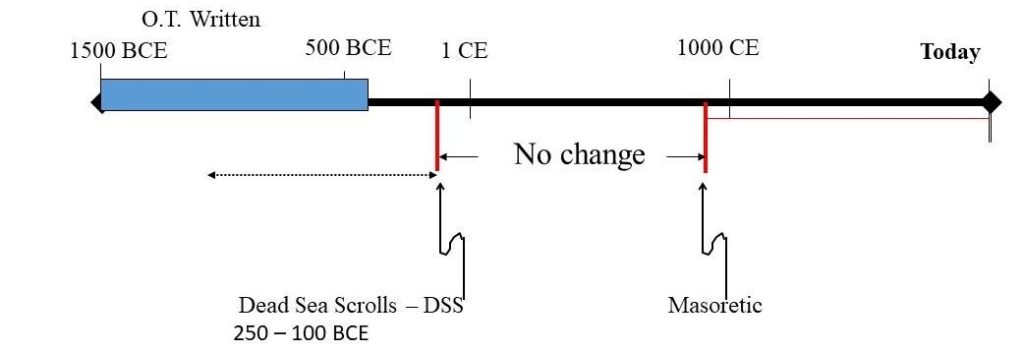
Scholars found almost no change in the Hebrew between the Masoretic Text and the Dead Sea Scrolls, though they jumped back 1000 years. In comparison, consider how much the English language has changed in the last 700 years, yet the remarkable Hebrew text remained static over such a great length of time.

Photograph: The Israel Antiquities Authority, Public domain, via Wikimedia Commons
Significance of the Dead Sea Scrolls for the Bible’s Integrity
The Dead Sea Scrolls support the Bible’s primary claim to authenticity. The New Testament claims that Jesus fulfills God’s Plan announced since the beginning of human history. The many Old Testament prophecies fulfilled by him throughout his life provides a central proof, or evidence, for this claim. The reasoning is as simple as it is logical. No human, no matter how clever, educated, or knowledgeable knows the future, especially when looking hundreds of years ahead. But God does know, and even sets up, the future. So if we find writings that correctly prophesy minute details of monumental events hundreds of years into the future they must have been inspired by God rather than merely thought up by men. You can think of the Old Testament prophecies forming a lock, waiting for a key to ‘fit’ into the lock to open it. Jesus claimed to be that key.
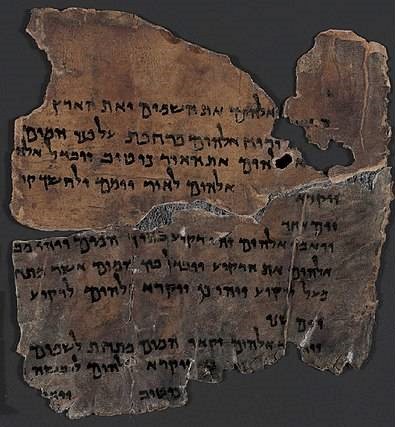
Photograph: The Israel Antiquities Authority, Public domain, via Wikimedia Commons
However, before the Dead Sea Scrolls, we did not have definitive proof that these prophecies were actually in writing before the events that they foresaw. Some dismissed them by arguing, for example, that perhaps the Old Testament prophecies of Jesus were ‘inserted’ into the Old Testament say in 200 CE. Since no Hebrew Old Testament text before 900 CE existed, that objection could not be quickly refuted. But with the Dead Sea Scrolls we find these prophecies had indeed been written down at the very latest by 100 BCE, 130 years before Jesus taught, performed miracles, and resurrected from the dead.
The Old Testament Prophecies in the Dead Sea Scrolls
So the Dead Sea Scrolls prove that the prophecies were in print before Jesus fulfilled them. The prophecies found in the Dead Sea Scrolls include:
- The coming Seed of the Woman
- The location of Jesus’ sacrifice
- The day in the calendar of Jesus’ sacrifice
- The day in the calendar of Jesus’ resurrection
- The details of Jesus’ crucifixion, including the piercing of his hands and feet
- The significance of Jesus’ sacrifice as one who will carry our sins
- The resurrection of Jesus
- The coming virgin birth
- The name of Jesus predicted
- The year that Jesus would be revealed as the Messiah
- The daily events of Passion Week
- The coming ‘Son of Man’
The Dead Sea Scrolls and Israel
The world discovered the Dead Sea Scrolls in 1948. This was the same year as the modern revival of Israel into a nation after almost 2000 years of Jewish exile. The timing of these two central events of the 20th century, being the same year, makes their remarkable re-entry to our world even seem scheduled by a Higher Power. Even just in their discovery, the Dead Sea Scrolls hint that The Mind foreordaining Jesus’ coming thousands of years ago seems to be still organizing events today.
